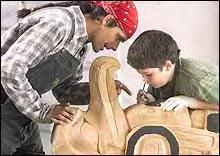|
|

Native American carver Tony Rath coaches Stevens Elementary fourth grader Archie
Sherwood in the fine points of painting a Northwest Coast style totem pole. This one was carved from a cedar that
was removed from school property during renovation.
Mike Urban/P-I
|
The towering red cedar shaded generations of schoolchildren
at Stevens Elementary, providing shelter for recess games and a scenic haven for young eyes staring through classroom
windows.
"Please
save our tree!" a class of first-graders wrote school officials last year, when they learned that a school
expansion would take out the more than 30-foot-tall landmark on Capitol Hill.
The tree,
built too close to the public school's foundation to survive the renovation, had to come down. But it has kept
on giving to the Stevens children.
Last summer,
school staff hauled the massive, branched trunk to the interim Green Lake site where the Stevens students are housed
this year.
There, over
the past few months, two Native American carvers have shaped the wood into a child-size totem pole that will have
a place of honor inside the renovated school. |
 Children helped strip away the rough bark from the bottom 6 feet of the tree, the section deemed
freest of knots and imperfections. Children helped strip away the rough bark from the bottom 6 feet of the tree, the section deemed
freest of knots and imperfections.
Tlingit carver Myron Barnes and his apprentice,
Tony Rath, an Apache, first carved away the golden outer layers of sapwood from the trunk and hollowed out the
reddish interior. Over the weeks, figures slowly emerged from the wood.
The carving style on the pole is authentic Northwest
Coast, but Barnes designed it in the spirit he felt would fit the school: A clawed bear cub at the bottom represents
the curious, eager young students, he said. The mama bear holding the cub stands for their nurturing teachers.
A human figure above the bear, legs drawn to his
chin, is the principal who guides the school. And the stern, beaked eagle at the top, salmon-patterned wings embracing
the lower figures, is the spirit who in turn guides the principal.
"I think it's pretty cool!" said Theresa
James, 10, one of the first in a series of fourth-grade students who helped paint the finished carving yesterday.
Like other students, she has fond memories of the
pole's previous incarnation.
"(The tree) was special . . . . I would run
around it, and play tag," she said.
The entire project, with the carvers serving as
artists-in-residence at the school, was part of a cultural studies unit for the fourth-grade classes of Christine
Wilke and Spencer Beard.
Beard, a member of the new building's design committee,
had commandeered the tree for Native American studies after learning it wouldn't survive the remodel. Cedar is
a wood historically used for totem poles.
Beard estimated the tree's age as similar to the
Stevens' building, or about 100 years. Rath placed it at closer to 200.
Over the months, Barnes and Rath spoke with students
about the whys and hows of carvings and totems. Students wrote stories featuring totem characters, visited the
pole to watch the carvers plane and chip decorations from its mass, and learned the uses of the different tools
the carvers used for each task.
The hands-on work was far more effective than traditional
teaching lectures, Beard said. In previous years, for instance, the teachers might have borrowed a box of Native
carving tools from the Burke Museum for the unit, holding one up and saying, "There's an adze."
This year, he said, they could point to Barnes
and Rath at work and say, "There's an adze -- chopping!"
The students have been especially keyed up this
past week, waiting for Barnes and Rath to put away their sharp carving tools so the fourth-graders could put on
their painting smocks and gloves and place their own stamp on the artwork. They began yesterday with thick brushes
and coffee cans full of black paint; they'll finish up this week with red and turquoise trimmings.
"This is my first time painting a totem pole,"
said Tam Duong, as he smoothed black paint over the glowing wood of the mama bear's foot. Enamored with the work,
he asked to paint some eyes next.
"It was exciting," said fellow fourth-grader
Treicy Castillo, who diligently angled a finer brush to paint one character's nose. She liked her work for its
neatness as much as the subject matter: "Sometimes when I paint, I mess up," she said.
The carvers will shave and smooth away any random
paint splatters or outside-the-lines missteps from their junior assistants. Both got a kick out of working with
the children, saying the students' questions enlivened the process and the classroom visits deepened it.
"They have their own ideas about things that
really make you think," said Barnes, who learned to carve in his hometown of Sitka, Alaska.
Rath, who smiled as the youngsters walked in with
cries of "Wow!" and "Cool!," said the totem pole has been a learning experience for him, too,
both in the project's size and its complexity.
It's been a pleasure to teach the children, he
said, and to show them the life within the wood of their old friend, "the life that is more than just a tree."
In the following sections you will find a story told with photos of
a totem pole being carved at Skidegate, Haida Gwaii
Carving at Skidegate
http://www.spruceroots.org/PoleSite/Haida.html

P-I reporter Rebekah Denn can be reached at 206-448-8190 or rebekahdenn@seattle-pi.com
|

